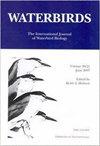eDNA Metabarcoding Analyses of Diet in Yellow-Billed Loons of Northern Alaska
IF 0.6
4区 生物学
Q3 ORNITHOLOGY
引用次数: 1
Abstract
Abstract. Environmental DNA is a burgeoning tool used to address wide-ranging scientific questions, including determining diets of difficult-to-sample predators. Loons are large piscivorous diving birds that capture and consume prey underwater, making it nearly impossible to visually determine their diet via observation alone. Identifying species' diets is important for understanding basic life history traits, and revealing key prey species can clarify species' roles in complex trophic webs, aid in understanding population and community dynamics, and help identify critical habitat for protection. Current information about loon diet is largely anecdotal, and traditional non-observational methods for quantifying loon diet have limitations. Analysis of eDNA from loon feces may provide biologists with a non-invasive technique for determining diet without negative sampling effects, and with increased resolution as compared to other techniques. We surveyed lakes in two areas of northern Alaska for Yellow-billed Loons (Gavia adamsii). Loon fecal samples were collected opportunistically from latrine sites without disturbing any animals and analyzed using novel marker sets to determine loon species and diet. Fish species were detected in all fecal samples, the most common being Alaska blackfish (Dallia pectoralis), and ninespine stickleback (Pungitius pungitius). This research demonstrates that eDNA metabarcoding analyses of loon fecal samples can determine the specific loon species that deposited the feces and characterize the piscine portion of their diet with limited disturbance to the animals.阿拉斯加州北部黄嘴龙饮食的eDNA元条形码分析
摘要环境DNA是一种新兴的工具,用于解决广泛的科学问题,包括确定难以取样的捕食者的饮食。潜鸟是一种大型食鱼潜水鸟类,它们在水下捕捉并消耗猎物,因此仅通过观察几乎不可能直观地确定它们的饮食。确定物种的饮食对了解物种的基本生活史特征具有重要意义,揭示关键猎物物种可以阐明物种在复杂营养网中的作用,有助于了解种群和群落动态,并有助于确定需要保护的关键栖息地。目前关于潜鸟饮食的信息大多是轶事,传统的非观测方法量化潜鸟饮食有局限性。从潜鸟粪便中分析eDNA可以为生物学家提供一种无创技术来确定饮食,没有负面采样效应,并且与其他技术相比具有更高的分辨率。我们对阿拉斯加北部两个地区的湖泊进行了调查,寻找黄嘴龙(Gavia adamsii)。在不干扰任何动物的情况下,从厕所地点收集潜鸟粪便样本,并使用新的标记集进行分析,以确定潜鸟的种类和饮食。在所有粪便样本中均检测到鱼类,最常见的是阿拉斯加黑鱼(Dallia pectoralis)和九棘棘鱼(Pungitius Pungitius)。本研究表明,对潜鸟粪便样本的dna元条形码分析可以确定沉积粪便的特定潜鸟物种,并表征其饮食中的鱼类部分,而对动物的干扰有限。
本文章由计算机程序翻译,如有差异,请以英文原文为准。
求助全文
约1分钟内获得全文
求助全文
来源期刊

Waterbirds
生物-鸟类学
CiteScore
1.30
自引率
0.00%
发文量
0
审稿时长
6-12 weeks
期刊介绍:
Waterbirds is an international scientific journal of the Waterbird Society. The journal is published four times a year (March, June, September and December) and specializes in the biology, abundance, ecology, management and conservation of all waterbird species living in marine, estuarine and freshwater habitats. Waterbirds welcomes submission of scientific articles and notes containing the results of original studies worldwide, unsolicited critical commentary and reviews of appropriate topics.
 求助内容:
求助内容: 应助结果提醒方式:
应助结果提醒方式:


